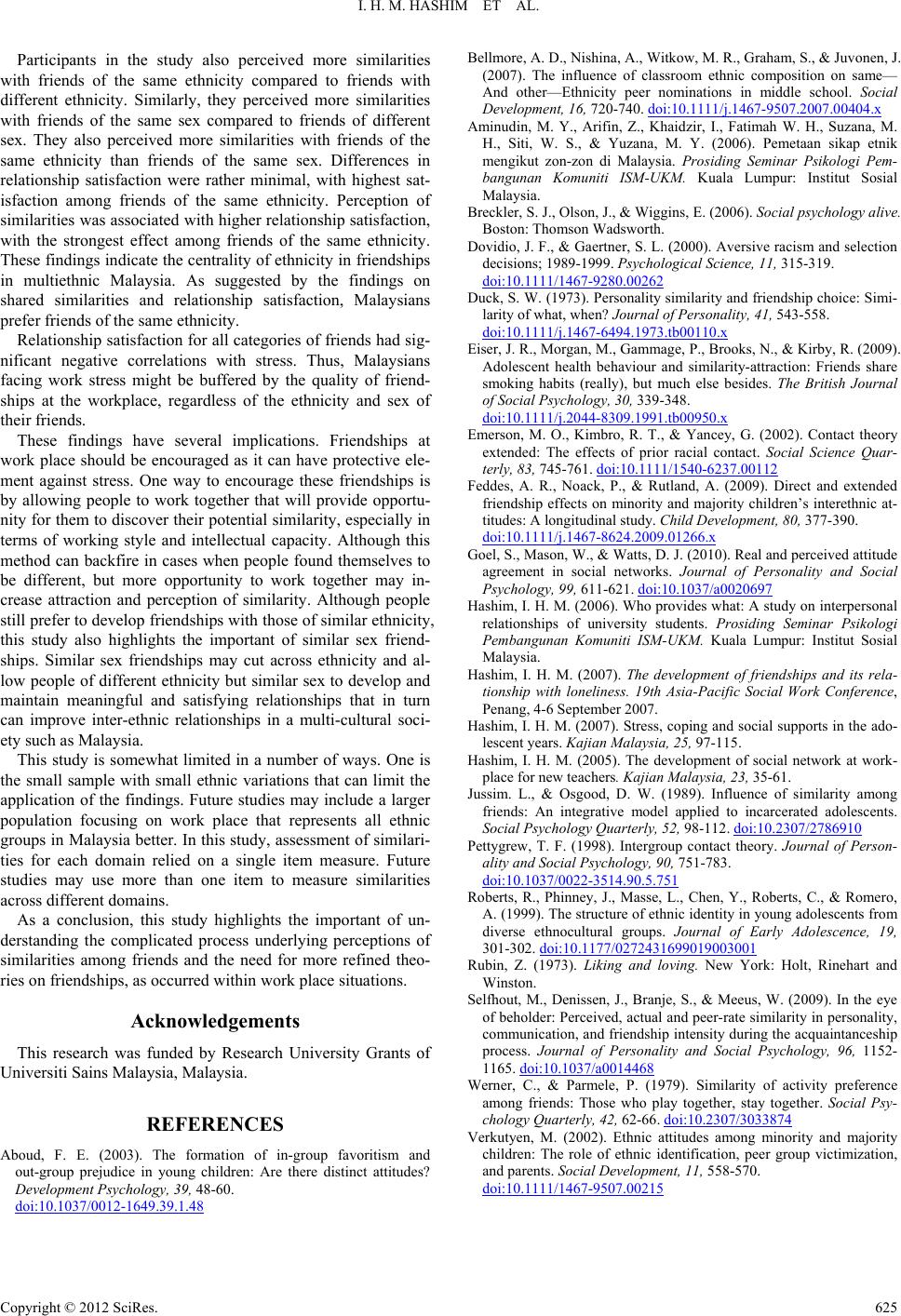
I. H. M. HASHIM ET AL.
Participants in the study also perceived more similarities
with friends of the same ethnicity compared to friends with
different ethnicity. Similarly, they perceived more similarities
with friends of the same sex compared to friends of different
sex. They also perceived more similarities with friends of the
same ethnicity than friends of the same sex. Differences in
relationship satisfaction were rather minimal, with highest sat-
isfaction among friends of the same ethnicity. Perception of
similarities was associated with higher relationship satisfaction,
with the strongest effect among friends of the same ethnicity.
These findings indicate the centrality of ethnicity in friendships
in multiethnic Malaysia. As suggested by the findings on
shared similarities and relationship satisfaction, Malaysians
prefer friends of the same ethnicity.
Relationship satisfaction for all categories of friends had sig-
nificant negative correlations with stress. Thus, Malaysians
facing work stress might be buffered by the quality of friend-
ships at the workplace, regardless of the ethnicity and sex of
their friends.
These findings have several implications. Friendships at
work place should be encouraged as it can have protective ele-
ment against stress. One way to encourage these friendships is
by allowing people to work together that will provide opportu-
nity for them to discover their potential similarity, especially in
terms of working style and intellectual capacity. Although this
method can backfire in cases when people found themselves to
be different, but more opportunity to work together may in-
crease attraction and perception of similarity. Although people
still prefer to develop friendships with those of similar ethnicity,
this study also highlights the important of similar sex friend-
ships. Similar sex friendships may cut across ethnicity and al-
low people of different ethnicity but similar sex to develop and
maintain meaningful and satisfying relationships that in turn
can improve inter-ethnic relationships in a multi-cultural soci-
ety such as Malaysia.
This study is somewhat limited in a number of ways. One is
the small sample with small ethnic variations that can limit the
application of the findings. Future studies may include a larger
population focusing on work place that represents all ethnic
groups in Malaysia better. In this study, assessment of similari-
ties for each domain relied on a single item measure. Future
studies may use more than one item to measure similarities
across different domains.
As a conclusion, this study highlights the important of un-
derstanding the complicated process underlying perceptions of
similarities among friends and the need for more refined theo-
ries on friendships, as occurred within work place situations.
Acknowledgements
This research was funded by Research University Grants of
Universiti Sains Malaysia, Malaysia.
REFERENCES
Aboud, F. E. (2003). The formation of in-group favoritism and
out-group prejudice in young children: Are there distinct attitudes?
Development Psychology, 3 9, 48-60.
doi:10.1037/0012-1649.39.1.48
Bellmore, A. D., Nishina, A., Witkow, M. R., Graham, S., & Juvonen, J.
(2007). The influence of classroom ethnic composition on same—
And other—Ethnicity peer nominations in middle school. Social
Development, 16, 720-740. doi:10.1111/j.1467-9507.2007.00404.x
Aminudin, M. Y., Arifin, Z., Khaidzir, I., Fatimah W. H., Suzana, M.
H., Siti, W. S., & Yuzana, M. Y. (2006). Pemetaan sikap etnik
mengikut zon-zon di Malaysia. Prosiding Seminar Psikologi Pem-
bangunan Komuniti ISM-UKM. Kuala Lumpur: Institut Sosial
Malaysia.
Breckler, S. J., Olson, J., & Wiggins, E. (2006). Social psychology alive.
Boston: Thomson Wadsworth.
Dovidio, J. F., & Gaertner, S. L. (2000). Aversive racism and selection
decisions; 1989-1999. Psychological Science, 11, 315-319.
doi:10.1111/1467-9280.00262
Duck, S. W. (1973). Personality similarity and friendship choice: Simi-
larity of what, when? Journal of Personality, 41, 543-558.
doi:10.1111/j.1467-6494.1973.tb00110.x
Eiser, J. R., Morgan, M., Gammage, P., Brooks, N., & Kirby, R. (2009).
Adolescent health behaviour and similarity-attraction: Friends share
smoking habits (really), but much else besides. The British Journal
of Social Psychology, 30, 339-348.
doi:10.1111/j.2044-8309.1991.tb00950.x
Emerson, M. O., Kimbro, R. T., & Yancey, G. (2002). Contact theory
extended: The effects of prior racial contact. Social Science Quar-
terly, 83, 745-761. doi:10.1111/1540-6237.00112
Feddes, A. R., Noack, P., & Rutland, A. (2009). Direct and extended
friendship effects on minority and majority children’s interethnic at-
titudes: A longitudinal study. Child Development, 80, 377-390.
doi:10.1111/j.1467-8624.2009.01266.x
Goel, S., Mason, W., & Watts, D. J. (2010). Real and perceived attitude
agreement in social networks. Journal of Personality and Social
Psychology, 99, 611-621. doi:10.1037/a0020697
Hashim, I. H. M. (2006). Who provides what: A study on interpersonal
relationships of university students. Prosiding Seminar Psikologi
Pembangunan Komuniti ISM-UKM. Kuala Lumpur: Institut Sosial
Malaysia.
Hashim, I. H. M. (2007). The development of friendships and its rela-
tionship with loneliness. 19th Asia-Pacific Social Work Conference,
Penang, 4-6 September 2007.
Hashim, I. H. M. (2007). Stress, coping and social supports in the ado-
lescent years. Kajian Malaysia, 25, 97-115.
Hashim, I. H. M. (2005). The development of social network at work-
place for new teachers. Kajian Malaysia, 23, 35-61.
Jussim. L., & Osgood, D. W. (1989). Influence of similarity among
friends: An integrative model applied to incarcerated adolescents.
Social Psychology Quar t e r l y, 52, 98-112. doi:10.2307/2786910
Pettygrew, T. F. (1998). Intergroup contact theory. Journal of Person-
ality and Social Psychology, 90, 751-783.
doi:10.1037/0022-3514.90.5.751
Roberts, R., Phinney, J., Masse, L., Chen, Y., Roberts, C., & Romero,
A. (1999). The structure of ethnic identity in young adolescents from
diverse ethnocultural groups. Journal of Early Adolescence, 19,
301-302. doi:10.1177/0272431699019003001
Rubin, Z. (1973). Liking and loving. New York: Holt, Rinehart and
Winston.
Selfhout, M., Denissen, J., Branje, S., & Meeus, W. (2009). In the eye
of beholder: Perceived, actual and peer-rate similarity in personality,
communication, and friendship intensity during the acquaintanceship
process. Journal of Personality and Social Psychology, 96, 1152-
1165. doi:10.1037/a0014468
Werner, C., & Parmele, P. (1979). Similarity of activity preference
among friends: Those who play together, stay together. Social Psy-
chology Quarterly, 42, 62-66. doi:10.2307/3033874
Verkutyen, M. (2002). Ethnic attitudes among minority and majority
children: The role of ethnic identification, peer group victimization,
and parents. Social Development, 11, 558-570.
doi:10.1111/1467-9507.00215
Copyright © 2012 SciRes. 625